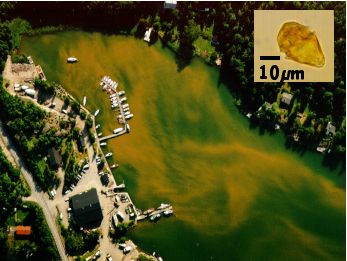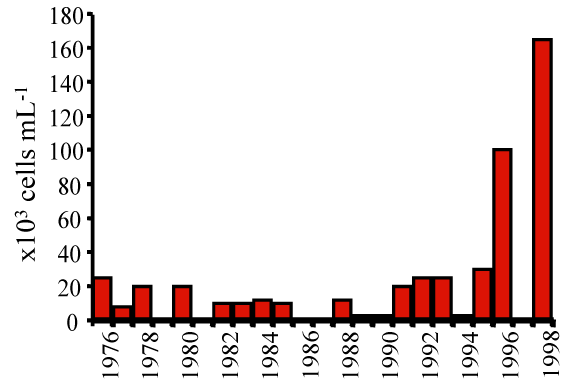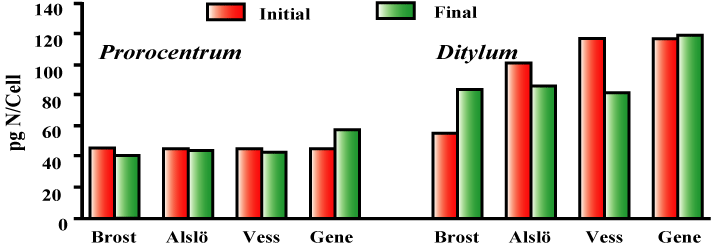


 |  |  | 9.2 Possible reasons behind the increase in harmful algal blooms |
Special weather and hydrographical conditions are thought to be prerequisites for the development of massive blooms of harmful algae to develop. Unfortunately no general scenario favouring a bloom of a specific species can be visualized. Blooms may be triggered by unusual weather events, occurring sporadically, as e.g. a rainy winter (runoff rich in nitrogen compounds and metals) followed by a sunny calm weather during the spring months (as was the case in the Chrysochromulina polylepis bloom, [302]). It is also possible that "global change", e.g. green house effects, have altered the potential for bloom development in general or the conditions for specific species. Even if special weather and hydrological (e.g. with respect to vertical stability of water masses) conditions are a prerequisite for bloom formation, they are probably not sufficient to cause a bloom to develop.
For a large biomass of phytoplankton to build up, a sufficient store or a continuous supply of nutrients is necessary. Thus, eutrophication, i.e. anthropogenically increased additions of nutrients to the aquatic environment, is probably an important factor behind increased harmful blooms events and especially the severity and longevity of the blooms [350].
Eutrophication symptoms, e.g. blooms of algae, some of them toxic, seem to be increasing, not decreasing, as e.g. in the Baltic Sea as a whole, in spite of the countermeasures taken to reduce N and P in these waters. The reason may either be that nitrogen loading does not control algal growth, or -- perhaps more likely -- that the system reacts slowly due to large internal stores of nutrients and a long residence time (>20 years). For example blooms of the dinoflagellate Heterocapsa triquetra, colouring many coastal embayments/fjords along the Baltic Sea during the month of June, have increased during the last 30 years [279].


Besides the resilience of the ecosystem with respect to inorganic nutrients, other factors may be involved in the continuation or even increase in HABs. One of those is organic nitrogen bound to humic material, which can directly or indirectly stimulate phytoplankton growth [73], especially HABs within the group of dinoflagellates and flagellates [190][193][72]; (Figures 14, 15). However, other phytoplankton species can also utilize humic material as e.g. Nodularia spumigena, a toxic cyanobacterium species responsible for blooms covering a major part of the Baltic Sea Proper during late summer, is able to utilize phosphorus from humic compounds to increase it's nitrogen fixation [367]. The loading of river-transported, high molecular weigth dissolved organic matter (humic and fulvic acids) to coastal waters can contain a major proportion of the total nutrient input. For the Baltic Sea for example, organic nitrogen bound to riverine humic material may contribute 50% of the total nitrogen being discharged [500].

Humic coloring of fresh water systems (lakes, rivers) in the Southern part of Sweden has been steadily increasing. For example, Romare and Cronberg [397] reported that in Lake Bolmen (SW Sweden), water color ( approx organic matter content) increased from 20 to 60 mg Pt L-1 (platinum) during 1996 - 2000, and in some of the lake's already very humic tributaries it doubled (e.g. from 150 to 300). The same trend is found for the tributaries of Lake Vättern, the second largest lake in Sweden. Between 1970 and 2000, organic carbon content increased by 50% [289] in tributaries. Many of these humic waters ultimately discharge into the Baltic Sea. An increase in the input of humic substances to the Baltic Sea was in fact noted already during the 1980s [10].

To decrease HABs and improve water quality in the Baltic Sea a threshold based mainly on the loading of inorganic N and P has been discussed. In those values organic nitrogen or phosphorus was thus not included, and until recently there has been only scanty knowledge on the availability of organically bound nutrients for HAB growth. Even now we are far from understanding what nutrients in e.g. humic matter represents for HAB biomass production in the Baltic Sea. One thing we can be rather confident about is that if there has been an increase in the number and severity of HABs over, say, the last 50 years (which there are strong indications for), it is safe to assume that the increase has to do with human activity. This may be due to direct pollution, but also indirectly through e.g. the greenhouse effect causing increased leakage of humic matter. Disruption of the entire food chain ending up in HABs due to overfishing (lack of "top down" control, [195]) is also a consequence of Man's activities. Thus not only loading of inorganic nutrients, but also organic matter loadings and fishing activities should be subjected to thresholds to manage algal blooms.
Several harmful algal blooms have been connected to an increased discharge of trace metals from land (see e.g. [493]). The "killer" algae Chrysochromulina polylepis has been shown to be stimulated by cobalt additions [194], while other algae were indifferent or even slightly inhibited by elevated levels of Co [191]. Cobalt levels 20 km from the coastline in the Kattegat are of the order of 0.35 nM and in the inner part of some fjords up to 3 nM, which is two orders of magnitude higher than in the open oceans [191].

Aquaculture, represented by the shellfish industry and fish farming in many European countries, is of extreme local importance in some areas. Aquaculture has suffered large economic losses during the last decades due to the occurrences of toxic/harmful phytoplankton blooms. However, we cannot discard the possibility that aquaculture itself (at least fish farming) by releasing extra nutrients (and by the use of antibiotic) might be one of the factors contributing to the development of HABs in enclosed small water bodies.

 |  |  | 9.2 Possible reasons behind the increase in harmful algal blooms |